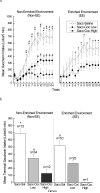Environmental enrichment protects against the acquisition of cocaine self-administration in adult male rats, but does not eliminate avoidance of a drug-associated saccharin cue
- PMID: 22157144
- PMCID: PMC3650841
- DOI: 10.1097/FBP.0b013e32834eb060
Environmental enrichment protects against the acquisition of cocaine self-administration in adult male rats, but does not eliminate avoidance of a drug-associated saccharin cue
Abstract
One of the most menacing consequences of drug addiction is the devaluation of natural rewards (e.g. food, sex, work, money, caring for one's offspring). However, evidence also suggests that natural rewards, such as an enriched environment, can devalue drugs of abuse. Thus, this study used a rodent model to test whether exposure to an enriched environment could protect adult rats from acquiring cocaine self-administration and from the resultant drug-induced devaluation of a natural saccharin reward cue. Adult male Sprague-Dawley rats were implanted with intravenous jugular catheters. Rats were then separated into two housing conditions: an enriched condition, including social companions(four/cage) and novel objects (e.g. balls, polyethylene tubes, paper, etc.), and a nonenriched condition where the rats were singly housed with no novel objects. During testing, the rats were given 5-min access to 0.15% saccharin, followed by 1 h to self-administer saline or cocaine (0.167 mg/infusion) on fixed ratio and progressive ratio schedules of reinforcement. The results showed that rats that were singly housed in the nonenriched environment fell into two groups: low drug-takers (n=34) and high drug-takers (n=12). In comparison, only one out of the 22 rats housed in the enriched environment was a high drug-taker. Thus, all rats in the enriched environment, except one, behaved like low drug-takers under the nonenriched condition. As such, these rats self-administered almost no drug on either the fixed ratio or the progressive ratio schedule of reinforcement and were extremely slow to self-administer their first cocaine infusion. Interestingly, despite their very low levels of drug self-administration, low-drug-taking rats housed in the enriched environment continued to avoid intake of the drug-associated saccharin cue. Taken together, these data suggest that the enriched environment itself served as a salient natural reward that reduced cocaine seeking and cocaine taking, but had little impact on avoidance of the cocaine-paired taste cue. The protective effects of the enriched environment were robust and, as such, have important implications for the methods used in the study of drug addiction in animal models and for the prevention, and possibly the treatment, of the disease in adult humans.
Figures






Similar articles
-
Greater avoidance of a heroin-paired taste cue is associated with greater escalation of heroin self-administration in rats.Behav Neurosci. 2015 Aug;129(4):380-8. doi: 10.1037/bne0000069. Behav Neurosci. 2015. PMID: 26214212 Free PMC article.
-
Cocaine-induced suppression of saccharin intake: a model of drug-induced devaluation of natural rewards.Behav Neurosci. 2002 Apr;116(2):321-33. Behav Neurosci. 2002. PMID: 11996317
-
Prior access to a sweet is more protective against cocaine self-administration in female rats than in male rats.Physiol Behav. 2013 Mar 15;112-113:96-103. doi: 10.1016/j.physbeh.2013.02.017. Epub 2013 Mar 6. Physiol Behav. 2013. PMID: 23474135 Free PMC article.
-
Nonhuman primate models of social behavior and cocaine abuse.Psychopharmacology (Berl). 2012 Nov;224(1):57-67. doi: 10.1007/s00213-012-2843-5. Epub 2012 Aug 16. Psychopharmacology (Berl). 2012. PMID: 22895674 Free PMC article. Review.
-
Environmental modulation of drug taking: Nonhuman primate models of cocaine abuse and PET neuroimaging.Neuropharmacology. 2014 Jan;76 Pt B(0 0):510-7. doi: 10.1016/j.neuropharm.2013.05.044. Epub 2013 Jun 7. Neuropharmacology. 2014. PMID: 23748095 Free PMC article. Review.
Cited by
-
Binge-like acquisition of 3,4-methylenedioxypyrovalerone (MDPV) self-administration and wheel activity in rats.Psychopharmacology (Berl). 2015 Jun;232(11):1867-77. doi: 10.1007/s00213-014-3819-4. Epub 2014 Nov 26. Psychopharmacology (Berl). 2015. PMID: 25424056 Free PMC article.
-
Towards a machine-learning assisted diagnosis of psychiatric disorders and their operationalization in preclinical research: Evidence from studies on addiction-like behaviour in individual rats.Eur J Neurosci. 2022 Dec;56(11):6069-6083. doi: 10.1111/ejn.15839. Epub 2022 Nov 1. Eur J Neurosci. 2022. PMID: 36215170 Free PMC article.
-
Greater avoidance of a heroin-paired taste cue is associated with greater escalation of heroin self-administration in rats.Behav Neurosci. 2015 Aug;129(4):380-8. doi: 10.1037/bne0000069. Behav Neurosci. 2015. PMID: 26214212 Free PMC article.
-
Compared with DBA/2J mice, C57BL/6J mice demonstrate greater preference for saccharin and less avoidance of a cocaine-paired saccharin cue.Behav Neurosci. 2013 Jun;127(3):474-84. doi: 10.1037/a0032402. Epub 2013 Apr 1. Behav Neurosci. 2013. PMID: 23544599 Free PMC article.
-
Dose titration with the glucagon-like peptide-1 agonist, liraglutide, reduces cue- and drug-induced heroin seeking in high drug-taking rats.Brain Res Bull. 2022 Oct 15;189:163-173. doi: 10.1016/j.brainresbull.2022.08.022. Epub 2022 Aug 28. Brain Res Bull. 2022. PMID: 36038016 Free PMC article. Review.
References
-
- Anthony JC, Helzer JE. Syndromes of drug abuse and dependence. In: L. N. Robins, Regier DA., editors. Psychiatric Disorders in America. Free Press; New York: 1991. pp. 116–154.
-
- Bardo MT, Klebaur JE, Valone JM, Deaton C. Environmental enrichment decreases intravenous self-administration of amphetamine in female and male rats. Psychopharmacology. 2001;155(3):278–284. - PubMed
-
- Belz EE, Kennell JS, Czambel RK, Rubin RT, Rhodes ME. Environmental enrichment lowers stress-responsive hormones in singly housed male and female rats. Pharmacology, Biochemistry, & Behavior. 2003;76(3-4):481–486. - PubMed
-
- Bennett EL, Rosenzweig MR, Diamond MC. Rat brain: Effects of environmental enrichment of wet and dry weights. Science. 1969;163(3869):825–826. - PubMed
-
- Bezard E, Dovero S, Belin D, Duconger S, Jackson-Lewis V, Przedborski S, Piazza PV, Gross CE, Jaber M. Enriched environment confers resistance to 1-methyl-4-phenyl-1,2,3,6-tetrahydropyridine and cocaine: Involvement of dopamine transporter and trophic factors. Journal of Neuroscience. 2003;23(35):10999–11007. - PMC - PubMed
Publication types
MeSH terms
Substances
Grants and funding
LinkOut - more resources
Full Text Sources
Medical
Research Materials

